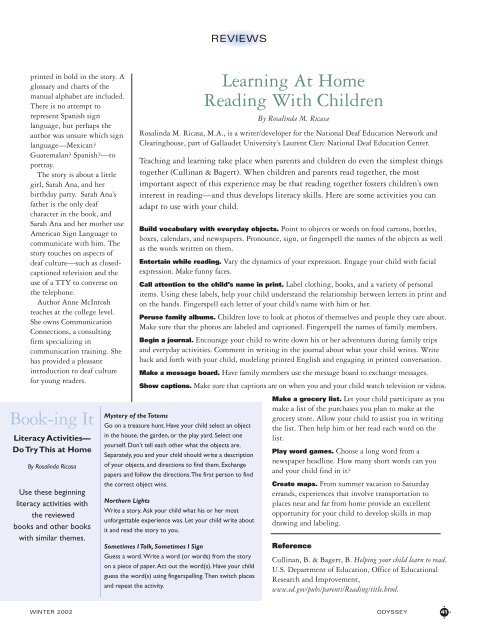practices - Gallaudet University
practices - Gallaudet University
practices - Gallaudet University
Create successful ePaper yourself
Turn your PDF publications into a flip-book with our unique Google optimized e-Paper software.
printed in bold in the story. A<br />
glossary and charts of the<br />
manual alphabet are included.<br />
There is no attempt to<br />
represent Spanish sign<br />
language, but perhaps the<br />
author was unsure which sign<br />
language—Mexican?<br />
Guatemalan? Spanish?—to<br />
portray.<br />
The story is about a little<br />
girl, Sarah Ana, and her<br />
birthday party. Sarah Ana’s<br />
father is the only deaf<br />
character in the book, and<br />
Sarah Ana and her mother use<br />
American Sign Language to<br />
communicate with him. The<br />
story touches on aspects of<br />
deaf culture—such as closedcaptioned<br />
television and the<br />
use of a TTY to converse on<br />
the telephone.<br />
Author Anne McIntosh<br />
teaches at the college level.<br />
She owns Communication<br />
Connections, a consulting<br />
firm specializing in<br />
communication training. She<br />
has provided a pleasant<br />
introduction to deaf culture<br />
for young readers.<br />
Book-ing It<br />
Literacy Activities—<br />
Do Try This at Home<br />
By Rosalinda Ricasa<br />
Use these beginning<br />
literacy activities with<br />
the reviewed<br />
books and other books<br />
with similar themes.<br />
REVIEWS<br />
Learning At Home<br />
Reading With Children<br />
By Rosalinda M. Ricasa<br />
Rosalinda M. Ricasa, M.A., is a writer/developer for the National Deaf Education Network and<br />
Clearinghouse, part of <strong>Gallaudet</strong> <strong>University</strong>’s Laurent Clerc National Deaf Education Center.<br />
Teaching and learning take place when parents and children do even the simplest things<br />
together (Cullinan & Bagert). When children and parents read together, the most<br />
important aspect of this experience may be that reading together fosters children’s own<br />
interest in reading—and thus develops literacy skills. Here are some activities you can<br />
adapt to use with your child.<br />
Build vocabulary with everyday objects. Point to objects or words on food cartons, bottles,<br />
boxes, calendars, and newspapers. Pronounce, sign, or fingerspell the names of the objects as well<br />
as the words written on them.<br />
Entertain while reading. Vary the dynamics of your expression. Engage your child with facial<br />
expression. Make funny faces.<br />
Call attention to the child’s name in print. Label clothing, books, and a variety of personal<br />
items. Using these labels, help your child understand the relationship between letters in print and<br />
on the hands. Fingerspell each letter of your child’s name with him or her.<br />
Peruse family albums. Children love to look at photos of themselves and people they care about.<br />
Make sure that the photos are labeled and captioned. Fingerspell the names of family members.<br />
Begin a journal. Encourage your child to write down his or her adventures during family trips<br />
and everyday activities. Comment in writing in the journal about what your child writes. Write<br />
back and forth with your child, modeling printed English and engaging in printed conversation.<br />
Make a message board. Have family members use the message board to exchange messages.<br />
Show captions. Make sure that captions are on when you and your child watch television or videos.<br />
Make a grocery list. Let your child participate as you<br />
make a list of the purchases you plan to make at the<br />
grocery store. Allow your child to assist you in writing<br />
the list. Then help him or her read each word on the<br />
list.<br />
Play word games. Choose a long word from a<br />
newspaper headline. How many short words can you<br />
and your child find in it?<br />
Create maps. From summer vacation to Saturday<br />
errands, experiences that involve transportation to<br />
places near and far from home provide an excellent<br />
opportunity for your child to develop skills in map<br />
drawing and labeling.<br />
Mystery of the Totems<br />
Go on a treasure hunt. Have your child select an object<br />
in the house, the garden, or the play yard. Select one<br />
yourself. Don’t tell each other what the objects are.<br />
Separately, you and your child should write a description<br />
of your objects, and directions to find them. Exchange<br />
papers and follow the directions.The first person to find<br />
the correct object wins.<br />
Northern Lights<br />
Write a story. Ask your child what his or her most<br />
unforgettable experience was. Let your child write about<br />
it and read the story to you.<br />
Sometimes I Talk, Sometimes I Sign<br />
Guess a word. Write a word (or words) from the story<br />
on a piece of paper. Act out the word(s). Have your child<br />
guess the word(s) using fingerspelling.Then switch places<br />
and repeat the activity.<br />
Reference<br />
Cullinan, B. & Bagert, B. Helping your child learn to read.<br />
U.S. Department of Education, Office of Educational<br />
Research and Improvement,<br />
www.ed.gov/pubs/parents/Reading/title.html.<br />
WINTER 2002 ODYSSEY 41

















